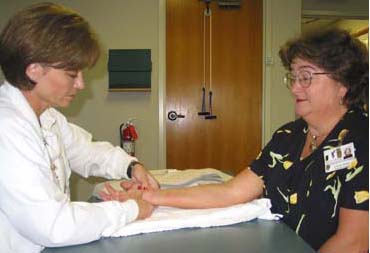JACKSON, Miss.—Carpal tunnel syndrome goes hand in hand with food processing jobs, and Mississippi’s preponderance of catfish, poultry and hog plants contributes to the state’s rising CTS rate.
But it’s not just industry that is to blame. Dr. Rahul Vohra, medical director of Methodist Rehabilitation Center in Jackson, said the poor health of many Mississippians also plays a role.
“Three big risk factors for carpal tunnel are obesity, diabetes and smoking. And we tend to have high rates of all three in Mississippi,” Vohra said.
“You also see a lot of women develop CTS during pregnancy because of increased fluid and weight gain,” said Pam Joyner, an occupational therapist at Methodist Rehab.
The reason has to do with the basic anatomy of the wrist. “There’s a narrow passageway in the wrist called the carpal tunnel, and it’s where the nerves and tendons run through,” explained Joyner. “When there’s swelling in that area, the median nerve can become compressed, causing numbness, tingling and pain. You usually feel it in the thumb, index and middle fingers.”
On the home front, CTS is associated with activities such as crocheting, needlepoint and gardening. On the job, CTS tends to afflict employees who repeatedly perform stressful motions with their hands, a common requirement of today’s fast-paced workplaces.
Catfish workers, for instance, might cut 100 catfish heads a minute. Some poultry workers make over 20,000 cuts a day. And many computer users stay glued to the keyboard and mouse for hours at a time.
“Technology has sped things up,” Joyner said. “Now we type 90-to-nothing with no rest breaks.”
While the Bureau of Labor Statistics doesn’t have specific CTS statistics for Mississippi, Joyner said her caseload indicates it’s “the up and coming epidemic.”
“I see about five new patients a week,” she said.
“It is escalating,” said Clyde Payne, area director of the Jackson office of Occupational Safety and Health Administration. “We see the highest numbers in the food processing industries, such as catfish, poultry and hogs.”
While the carpal tunnel is in the wrist, that’s not where the pain of CTS is confined, Joyner said. “You can have pain from your fingertips to your shoulder. CTS is still easily misdiagnosed. Every now and then I’ll have a patient who has had it for 15 years, but the doctor said it was arthritis.”
One way to definitively diagnose CTS is to have patients undergo electromyography (EMG) and nerve conduction studie (NCS), said Dr. Art Leis, senior scientist for the Center for Neuroscience and Neurological Research at Methodist Rehab. The EMG assesses muscle function, said Leis, while the NCS measures how quickly impulses travel between nerves.
“These tests offer several advantages,” Leis said. “They can detect injury to the median nerve, localize the injury to the region of the carpal tunnel, evaluate the severity of injury, determine the patient’s prognosis and allow an objective follow-up after any type of medical management or intervention.”
Once CTS is confirmed, patients can begin traditional therapies such as modifying their workstations, wearing a wrist-support splint, taking anti-inflammatory drugs and attending occupational therapy sessions.
“Typically, that will reduce symptoms,” Joyner said. “If it doesn’t, the next treatment is cortisone injections, which help cool down the inflammation. If the symptoms persist, you’re looking at surgery.”
Surgery for CTS involves dividing the transverse carpal ligament to relieve pressure on the nerve. Therapy follows, and the sooner the better, Joyner said. “We’re very aggressive with post-op treatment. The sooner they start moving, the better they do.”
To help patients prevent recurrent CTS pain, Joyner emphasizes proper posture and positioning. “I also tell them to stretch frequently, listen to their symptoms and pace themselves. People who do gardening and crafts are the worse. They’ll say: ‘I’m going to finish this afghan even if it kills me.’ ”
Joyner also advises patients to alternate activities -- to break up periods of typing with other duties, such as faxing or filing, and to stop frequently to stretch hands and wrists.
Many employers also recommend such prevention strategies because they’ve come to understand the impact of early intervention on their company’s bottom line. “If CTS becomes severe and requires surgery, the employee is out much longer, the costs are much higher and the pain and suffering is much greater,” Payne said. “So there is heightened awareness in corporate America of the value of safety and health.”
To encourage employers who are not so savvy, OSHA has been doing a lot of enforcement work, Payne said. “If we do an inspection, we are looking for hazards.”
Payne said employers are encouraged to have a means for employees to report illnesses and injuries, to provide training on ergonomic issues, to have evaluations of work areas and to implement engineering and administration controls to reduce CTS cases.
“There is a lot an industry can do,” he said. “They just need to be proactive.”
Carpal Tunnel Syndrome Prevention Tips
- When working at your desk, use a comfortable chair at the proper height. Elbows should be at 90 degrees, hips at 90 degrees, the lower back supported and feet flat on the floor or on a footrest.
- Avoid using your wrist in a bent (flexed), extended or twisted position for long periods of time.
- When typing, avoid resting elbow or forearm on the edge of your desk or over-reaching with fingers or arms. Hit keys lightly.
- Avoid or limit working for long periods in cold temperatures.
- Avoid or limit activities that require constant gripping or vibration i.e. using power tools
- Reduce work speed and pace yourself. Take frequent work breaks or rotate work activities.
- Do stretching exercises before work, hourly at desk and after work.
- Use adaptations if helpful: wrist support devices, wrist splint, foot rest, document holder and telephone headset.

